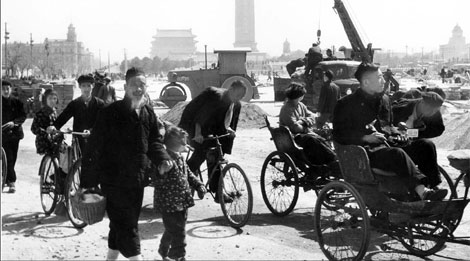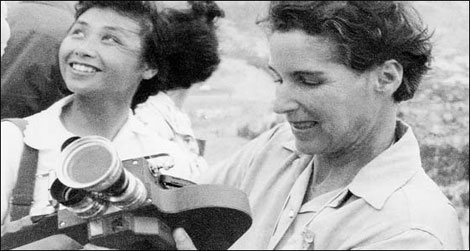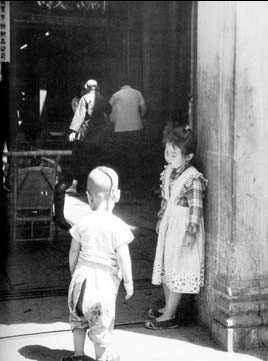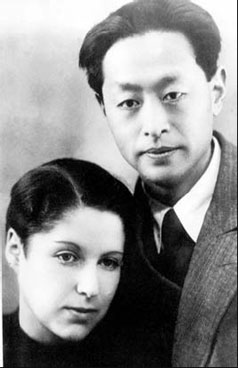Life and Leisure
Hidden pictures
By Chihua Wen (China Daily)
Updated: 2010-08-19 13:24
 |
Large Medium Small |

People wearing old and new clothes pass by Tian'anmen Square, under construction in the early 1950s. Photos provided to China Daily |
The once-suppressed photographs of a camera-toting foreign newswoman, who was later imprisoned as a spy, offer an insight into ordinary life around the dawn of New China. Chihua Wen reports
A boy is caught in the light, clad in open-backed pants, a tiny pigtail drooping from the top of his shaved head. A girl stands in the shade, wearing a platje, a fashionable dress in the Soviet Union in the 1950s. Two women - one with bound feet - walk shoulder to shoulder into the distance.
This photograph, The Pigtail and the Open-backed Pants, captures the sharp contrasts of downtown Beijing in the early 1950s - the young and the old, the dark and the bright - opening a window on a China in transition.
But at that time, such a photo would never be approved by China's official Xinhua News Agency, where Eva Siao, a German Jewish photographer, worked on and off for a decade.
The people in the picture do not look happy. They do not exemplify the glory of New China that Xinhua wanted to promote.
Siao captured images of four people from three generations. Only the little girl's face is visible, appearing more lost than happy.
"In those days, photographs should show people's full faces - happy and fulfilled people enjoying the unprecedented happy life that signified socialist China," says Chen Xiaobo, a senior Xinhua photo editor working on the oral history of the news agency's photographers, including Siao.
Siao was born Eva Sandberg. She was the daughter of a Jewish doctor in Breslau, Germany, but was swallowed up by the political ups and downs of China, her adopted homeland, for three decades.
Her fateful connection with the country was sealed on Nov 8, 1917. That day, she received a special gift for her sixth birthday - a book and a letter from the Chinese emperor.
In the letter bearing his signature, the emperor said he had fallen in love with her after seeing her photograph and wanted to marry her. The book would help her learn Chinese, so they could wed when she grew up.
Eva had no idea China's last imperial dynasty had been overthrown by Sun Yat-sen's Xinhai Revolution in 1911, the year she was born.
"Yes, she honestly believed the letter, which was actually written by her brother, Herbert," her son Viktor Siao, or Xiao Weijia, explains in his Beijing apartment.
The letter read like the opening of a fairy tale. But it turned out to be more like a prophecy.
Years later, Siao did meet the last Chinese Emperor Puyi. By then, she had married Xiao San, a quintessential Chinese Communist and principal translator of the Internationale from French into Chinese.
Siao met Emi Siao (Xiao San's penname) when she was on vacation on the Black Sea in 1934. She was 23 and had just graduated from Munich Film Institute. Emi was a 41-year-old revolutionary poet. He had traveled to the Soviet Union in 1927 to promote the Chinese Communist revolution. She followed him to Moscow.
The rising fascist threat of Hitler made it impossible for them to live in the USSR. Siao gave up her German citizenship for love. She became a Soviet citizen and married Emi in 1935.
In 1939, Emi returned to China alone. He could not take his wife along, because it was a secret trip. To avoid persecution, Siao went to live with her brother Herbert, a conductor with the Royal Opera Theater of Sweden.
A year later, with Mao Zedong's approval, Siao left Stockholm for the rugged six-week journey to reunite with Emi in Yan'an, the cradle of the Chinese Communist revolution in northwestern Shaanxi province.
Her husband was Mao's high school classmate. Siao got to know Mao and his comrades, including Zhou Enlai, who would become the first premier of New China, and Liu Shaoqi, later the vice-president.
She often danced with them on the weekends. Mao was not a good dancer, she says.
In her autobiography China, My Dream, My Love (1990), Siao writes: "It was more like strolling on the music beats than dancing."
But many in the Party's left wing suspected Eva of being a spy, and she was forbidden from photographing in Yan'an.
"I could have taken many historical pictures of the Communist Party of China in Yan'an. It's a pity," Siao says in her autobiography.
Her life as professional photographer started after 1949.
In 1950, she landed a job with Xinhua with the help of high-ranking friends, such as Hu Qiaomu.
Despite her powerful support and her wholehearted enthusiasm for her work, Siao was not trusted politically.
"She was never assigned to shoot important political events or figures," says Viktor, the second of the three sons she had with Emi. He was born in Yan'an in 1941.
"She was required to submit 15 publishable photos a month. This was easy for her," Viktor says.
"Ironically, it also left her with the time and freedom to shoot what she loved."
Viktor recalls his mother always rode a bike around Beijing carrying a camera, hunting for interesting people at work or chatting.
"She was very quick, and could always grasp that significant moment before they noticed her," Viktor says.
In the picture Is That Sweet? Siao framed an intimate scene outside the Forbidden City.

As a photographer with Xinhua News Agency, Eva Siao spent every day on the street capturing the lives of ordinary people. |

The Pigtail and the Open-backed Pants, by Eva Siao. |

Eva Siao met Xiao San, aka Emi Siao, a Chinese revolutionary, in 1934. |
A mother squats on the sidewalk, feeding her son watermelon. The woman looks as if she may not have been in the city very long.
She hasn't assumed the posture city people show in public. Her stance does, however, demonstrate deep love and affection for her son.
"No photographer from Xinhua would ever take this picture," Siao once told Viktor.
"They always turned their lenses on grand topics and subjects. But I'm more interested in people, especially ordinary people."
Xinhua assigned a Chinese editor to work with Siao. The editor only wanted posed pictures. The subjects had to be well dressed, smile and show optimism.
But Siao had different criteria - no posing, no pretentiousness and no fake smiles. Let the picture tell the story, that was her motto.
"People don't normally smile when concentrating on their work," she told the editor.
"In fact, a serious look reveals their optimistic will to build a better China."
Consequently, the editor turned down most of the pictures Siao shot, calling them, "incorrect".
But she persisted in practicing what she believed is the "soul of photography".
She snapped pictures of hundreds of ordinary and extraordinary people in every imaginable field of endeavor.
She shot vendors repairing parasols and shoes, construction workers renovating Tian'anmen Square, and Tibetan farmers, socialites and artists.
The black-and-white and color works show a sympathetic and humane view of daily life in China in the mid-20th century. They capture the intensity and dignity of the personalities, Chen Xiaobo says.
In 1964, after Sino-Soviet relations had soured, Siao assumed Chinese citizenship so she could stay in China.
But on Oct 8, the day when she received the citizenship certificate signed by Premier Zhou Enlai, Siao lost her job. No one could, or dared to, hire her because of her and her husband's experience in the Soviet Union.
In June 1967, when the storm clouds of the "cultural revolution" started to gather, Siao was arrested as a spy while preparing dinner at home. Shortly after, her husband was also detained as a spy on his way home from a walk. Both were sent to Beijing's Qincheng prison.
For more than seven years, the couple was held in separate solitary confinement cells without even knowing the other had also been arrested.
"They wanted my parents to admit they were spies, but they wouldn't," Viktor recalls.
They were rehabilitated in 1979, three years after the "cultural revolution" ended. Emi died in 1983, and Siao passed away on Nov 12, 2001, four days after her 90th birthday.
She left behind more than 10,000 pictures of China.
"They may not have fit Xinhua's idea of a good image then," Chen Xiaobo says.
"But they create a comprehensive picture of contemporary Chinese people that reflects their accomplishments and the challenges they confronted and still confront."